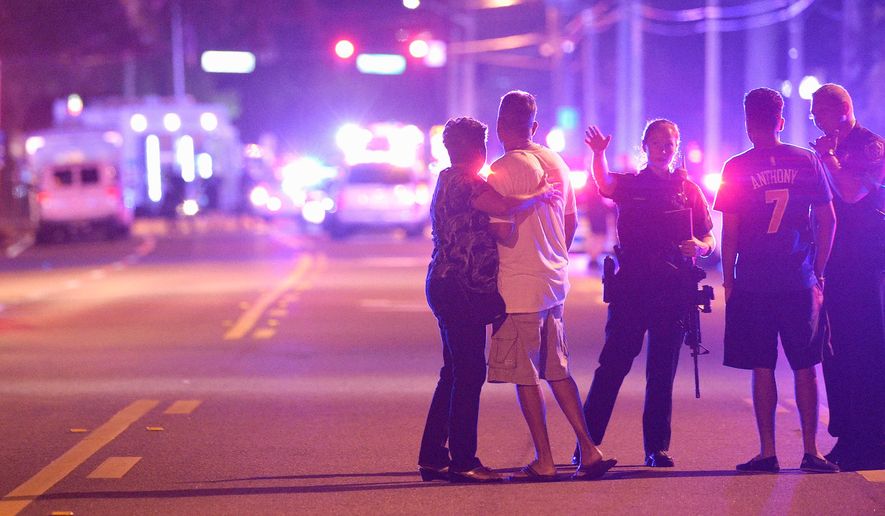Last year’s Orlando nightclub shootings propelled the annual number of deaths linked to domestic extremist-related attacks to their highest level in decades and made Islamist extremism the deadliest ideology for the first time in 30 years.
According to a new report from the Anti-Defamation League, the preliminary tally of homegrown extremist-related deaths in the U.S. shows that 69 people died in such attacks last year, the most since the 1995 Oklahoma City bombing.
Omar Mateen’s pledge of allegiance to the Islamic State and al Qaeda during the Pulse nightclub massacre led to classification of the attack, which killed 49 people, as domestic Islamic extremism — setting 2016’s figures far afield from prior years. For the past 30 years, extremism-related deaths were most commonly likely to be linked to right-wing ideologies, the report states.
Of the 372 people killed in the U.S. over the last 10 years by domestic terrorists, 74 percent died at the hands of right-wing extremists. About 24 percent were killed by domestic Islamists, and the remaining 2 percent killed by left-wing extremists, according to the report released Thursday.
“Anti-government extremists and white supremacists were responsible for only a minority of extremist related deaths in 2016, though they did commit two triple homicides,” states the ADL report “Murder and Extremism in the United States in 2016.”
“These low figures also occurred during a year in which non-violent right-wing extremist activity was high, in large part due to agitation and propaganda by the so-called alt-right and other extremists in connection with the 2016 presidential election,” the report stated.
ADL notes that homicides by white supremacist groups were uncharacteristically low in 2016, and that such groups “are typically responsible for more such killings than any other extremist movement.”
The ADL has not included the Sept. 11 terrorist attacks in this or similar past surveys because the attack was masterminded abroad and carried out by foreigners.
“In a country as large as the United States, no one extremist group or movement has a monopoly on violence,” said Oren Segal, director of ADL’s Center on Extremism and an author of the report. “It is clear from the trends that we cannot ignore one threat of extremism over another. Extremists come in many forms, and extremist violence, whether inspired by [Islamic State] or carried out in the name of white supremacy, is still very much a serious threat.”
A separate report issued this week by the Southern Poverty Law Center found that the number of hate groups operating in the U.S. last year increased, with a noticeable spike in the number of anti-Muslim groups.
The center’s report blamed that spike on both anger over terrorist attacks such as the Orlando nightclub shooting and President Trump’s “incendiary rhetoric, including his campaign pledge to bar Muslims from entering the United States.”
ADL analysts caution in their report that the high number of deaths in the Orlando massacre can distort statistics and perceptions of the extremist landscape in the country, and were it not for that single attack, 2016 might have been considered a “mild year” for extremist-related deaths.
Including the Orlando attack, the ADL report counts 11 lethal incidents and 69 deaths that were connected to extremism in 2016 — compared to 29 incidents that resulted in 65 deaths in 2015. Experts say additional analysis may result in an increase in the number of deaths associated with domestic extremism, as has been the case in prior years.
Among the other lethal incidents highlighted by the ADL was the targeting of police officers by black nationalists. In July, two separate attacks on law enforcement by men with black nationalist ties left eight police officers dead.
The attacks, in Baton Rouge, Louisiana, and Dallas, “represent the worst spate of black nationalist-related murders of police officers since the late 1960s and early 1970s, when more than two dozen police officers, and several more corrections officers, were killed by black nationalists, particularly from the Black Liberation Army and the Black Panther Party,” the ADL report states.
In Dallas, 25-year-old Army veteran Micah Xavier Johnson opened fire on police officers as hundreds gathered to protest fatal police-involved shootings in Baton Rouge and St. Paul, Minnesota.
Less than two weeks later, gunman Gavin Long fatally shot three officers in Baton Rouge. Authorities said the gunman identified himself as a black nationalist.
Since 1965 the ADL reports that 104 police officers have been killed by domestic extremists — including 57 by right-wing individuals, 44 by left-wing individuals including anarchists and black nationalists, and three have been killed by domestic Islamists.
• Andrea Noble can be reached at anoble@washingtontimes.com.




Please read our comment policy before commenting.